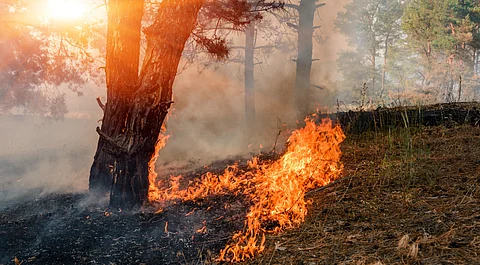

Carbon dioxide (CO₂) levels in the atmosphere surged in 2024, driven by wildfires and anthropogenic emissions, breaking all previous records, according to the Keeling Curve — an iconic 67-year record of atmospheric CO₂ maintained at the Mauna Loa Observatory since 1958.
The average CO₂ concentration for 2024 was 3.58 parts per million (ppm) higher than the previous year, exceeding the previous record increase of 3.41 ppm. As of January 21, 2025, CO₂ levels had reached 427.1 ppm, the highest in millions of years, according to UC San Diego’s Scripps Institution of Oceanography.
Ralph Keeling, who leads the CO₂ monitoring programme at Scripps, highlighted the role of climate phenomenon El Niño in this unprecedented rise in a press statement. El Niño occurs when surface temperatures in the central and eastern Pacific Ocean rise above average. This is part of the El Niño-Southern Oscillation cycle, alongside the La Niña phase.
“Although this El Niño event ended early in 2024, it is often the case that El Niño events are associated with higher than normal CO₂ growth extending into the northern hemisphere summer following the El Niño event,” he explained. “This last year fit that pattern, but wildfires in North and South America may have further boosted the CO₂ growth.”
The use of fossil fuels contributes to rising CO₂ emissions. However, the rate of emissions fluctuates due to interactions with ocean and land ecosystems and fires. The statement from Scripps stated that the CO₂ levels are not only the highest in millions of years but also growing at a record pace.
According to Keeling, the numbers confirm that the planet is entering uncharted territory at a faster rate than ever before as its rise accelerates.
The findings align with Keeling and the United Kingdom Met Office’s annual CO₂ increase forecasts. According to the latter’s researchers, the rise contradicts the Intergovernmental Panel on Climate Change’s projections for limiting long-term average global warming to 1.5 degrees Celsius above pre-industrial levels.
“Limiting global warming to 1.5°C would require the CO₂ rise to be slowing, but in reality the opposite is happening,” said Richard Betts, head at the Met Office CO₂ forecast team. “Even without the boost from El Niño last year, the CO₂ rise driven by fossil fuel burning and deforestation would now be outpacing the IPCC’s 1.5°C scenarios.”
A May 2024 report from Scripps noted a record monthly increase of 4.7 ppm in March 2024 compared to March 2023. This broke the previous record of a 4.1 ppm monthly rise recorded during the 2015–2016 El Niño event.
The 2024 monthly average exceeded the previous record of 4.1 ppm from June 2015 to June 2016, when El Niño conditions influenced global weather and contributed to rising CO₂ levels.